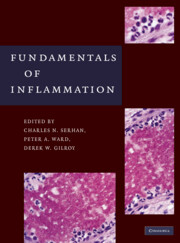Book contents
- Frontmatter
- Contents
- Contributors
- Preface
- PART I THE INFLAMMATORY RESPONSE – AN OVERVIEW
- PART II INDIVIDUAL CELL TYPES
- PART III CHEMICAL MEDIATORS
- PART IV IMMUNOPHARMACOLOGY
- PART V INFLAMMATORY DISEASES/HISTOLOGY
- PART VI ANIMAL MODELS OF INFLAMMATION
- 27 Models of Acute Inflammation – Air-Pouch, Peritonitis, and Ischemia-Reperfusion
- 28A Experimental Models of Glomerulonephritis
- 28B Glomerulonephritis and Ischemia Reperfusion Injury
- 29 Asthma
- 30 Animal Models of Rheumatoid Arthritis
- 31 Ocular Inflammation Models
- 32 Atherosclerosis in Experimental Animal Models
- 33 Oral Inflammation and Periodontitis
- 34 Pathogens and Inflammation
- Index
- References
27 - Models of Acute Inflammation – Air-Pouch, Peritonitis, and Ischemia-Reperfusion
from PART VI - ANIMAL MODELS OF INFLAMMATION
Published online by Cambridge University Press: 05 April 2014
- Frontmatter
- Contents
- Contributors
- Preface
- PART I THE INFLAMMATORY RESPONSE – AN OVERVIEW
- PART II INDIVIDUAL CELL TYPES
- PART III CHEMICAL MEDIATORS
- PART IV IMMUNOPHARMACOLOGY
- PART V INFLAMMATORY DISEASES/HISTOLOGY
- PART VI ANIMAL MODELS OF INFLAMMATION
- 27 Models of Acute Inflammation – Air-Pouch, Peritonitis, and Ischemia-Reperfusion
- 28A Experimental Models of Glomerulonephritis
- 28B Glomerulonephritis and Ischemia Reperfusion Injury
- 29 Asthma
- 30 Animal Models of Rheumatoid Arthritis
- 31 Ocular Inflammation Models
- 32 Atherosclerosis in Experimental Animal Models
- 33 Oral Inflammation and Periodontitis
- 34 Pathogens and Inflammation
- Index
- References
Summary
IMPORTANCE OF STUDYING CELL TRAFFICKING IN VIVO
The innate response has long been compartmentalized into several facets traditionally termed redness, heat, pain, and edema. Inflammatory insults induce release of a plethora of tightly regulated intra- and extracellular mediators, rapidly modulating the local microenvironment. The initial “humoral” response is largely a nongenomic reaction conducted by constitutive proteins and metabolic products released by resident cells (depending on the site of insult), for example, histamine, tumor necrosis factor alpha (TNF-α), and metabolites of the arachidonic acid cascade. These nonspecific or “classical” signals concurrently increasing vascular dilation, permeability, and blood flow to allow the exudation of fluid and protein. Consequentially, a variety of systemic mediators, cytokines, chemokine, and centrally acting molecules are produced to orchestrate cellular infiltration, local activation of blood-borne cells, and dispose of the inflammogen; ultimately, resolution of inflammation occurs in a time-dependent and space-regulated fashion, resulting in restoration of tissue integrity. When these symptoms persist, through deregulation or repeated insult, chronic inflammatory conditions (such as rheumatoid arthritis [RA]) can occur resulting in loss of function locally as well as effecting systemic pathology.
Among this multitude of molecular and cellular processes, migration of blood white cells to the site of inflammation is central to the overall response orchestrated by the host.
- Type
- Chapter
- Information
- Fundamentals of Inflammation , pp. 329 - 337Publisher: Cambridge University PressPrint publication year: 2010
References
- 3
- Cited by



